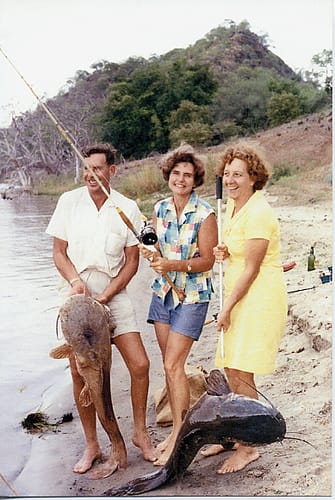The Big Catch At Kariba

Bill and Merlin Atkinson and Mom with the big catch at Lake Kariba, 1964
The Big Catch at Kariba
The rescue of wild animals from the rising waters of Lake Kariba was called Operation Noah. Clouds of birds came to feed on insects and rodents as they were flushed from their nests as they submerged. Sheets of ants floated on the surface of the lake. In the water below tigerfish rampaged with the glut of insects.
The Big Catch at Kariba
Sometimes the lake rose as much as ten feet a day. Drowning mopane trees shed their bark but the wood endured as a petrified forest. Sometimes trees dripped with snakes, at other times they were festooned with birds like fish, snake, hawk, and martial eagles or cormorants, storks, vultures, hornbills, and hoopoes. When the lake stabilized, fish inhabited the petrified forests.
My family never went fishing. But in 1964 we were invited to join the Atkinsons of the Turtle Mine and the De Beers of the Roasting Plant on a fishing trip to Kariba.
They had boats and the gear, with enough to spare to kit us out too. We reserved chalets on the water. I brought along my best friend, Doffy Newham from St. Peter’s Diocesan School in Bulawayo. She also knew nothing about fishing. Her father, who had been the postmaster in Salisbury, now in retirement farmed chinchillas for their pelts. They were running out of names for the chinchillas and I wondered how long the business would last.
As was customary, we brought our servants and our food supplies with us. Still, it seemed to take a lot to get us going and actually launched in the mornings.
We were schooled on the types of spoons used to attract different kinds of fish, especially the fighting tigerfish. It was a science we soon realized. Alternatively we could use fresh bait: smallish fish or frogs. Tigerfish are even cannibals, going for strips of the underbelly neatly threaded on a hook. All the same, they could strip a hook clean without hooking themselves, so they said. They were unpredictable once hooked, going off at a terrific pace in any direction, leaping up into the air here and there, giving the angler a real workout, as he was played out.
Although tasty, tigerfish were not one for the frying pan, having too many forked, fine bones. Bream (tilapia), as delicious as sole, were the thing to catch for good eating. They required a very light line, baited with worms, flying ants or grasshoppers. It all depended on what fish you were after. What were Doffy and I after? We’d rather stroke chinchillas.
But, once we set out, it was a vundu, a huge catfish, that Mom caught, really without even trying, with a left over chicken leg from lunch for bait. It came up for a short run and then lay down again on the bottom and sulked. Bill Atkinson tried all sorts of maneuvers to get it moving again, to no avail. Finally when everyone had forgotten about it, including Mom, it came to life and gave a good account of itself before Bill, tall, strong and sinewy, leaned over with a gaff and hauled it in.
As well as avoiding submerged trees, Kariba weed was a hazard. It was quite a job, tilting the motor up, leaning over and pulling the mass of tangled weed from it. It also formed great floating islands. Not only did these carpet the lake but they were thick and deep, so that it seemed you could walk on them. Like much else at Kariba they were fabulous but we only thought of them as a threat to the boats, the lake itself and the hydro electric turbines.
See epic pictures of the building of Kariba made available by Alan Smith on Eddy Norris’ web site.
http://rhodesianheritage.blogspot.com/2011/05/kariba-gorge-scheme.html
